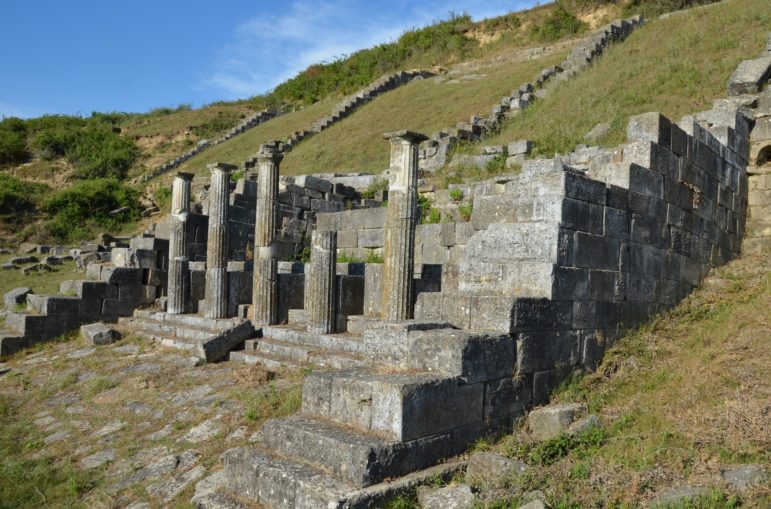FIERI, Fier County, Albania – Vandals attacked a Greek nymphaeum in the ruins of Apollonia in the Illyria region of classical antiquity that is now part of modern-day Albania. The site was named in honor of Apollon, a major Olympian in Hellenic religion who is commonly referred to in English as Apollo.
The vandals reportedly knocked down and smashed two columns, doing irreparable damage to the UNESCO World Heritage site. No motive is apparent and there are no reports of damage elsewhere on site.
An Albanian official said that they had reported the incident to the police. The official also said that efforts were now underway to attempt to restore the monument.
This latest report of vandalism to important ancient historical sites that are considered sacred to the Pagan community joins other reports from sites in the U.K. that TWH has covered recently. The reports of vandalism have occurred during the pandemic when sites are more vulnerable due, in part, to the sites being closed to the public and having less monitoring.
According to the Archaeology News Network, the Greeks built nymphaion to honor nymphs and their springs. The Greeks built them over the springs, where often a natural grotto had already formed and was believed to be where the nymphs lived. Sometimes a nymphaeum would function as a water source or a monumental fountain.

The Nymphaeum fed by the underground water sources, built in the middle of the 3rd century BC, is the biggest and best-preserved monument of Apollonia covering an area of 1,500 square meters, Apollonia, Albania. [Image credit: Carole Raddato – CC BY 2.0]
The Romans adopted and modified these Greek structures. The Romans, however, built them as rotundas, filled with statues and paintings. Nymphaea were also important in the development and use of mosaics.
In the Roman period, they functioned as “reservoirs and assembly-rooms.” Frequently, they were the site of marriage rites. It is not clear if the Romans modified the original Greek design at Apollonia.

Apollonia (Illyria) Archaeological Park, Monument of Agonothetes, Albania – Image credit: Pudelek, CC BY-SA 4.0
The Monument of Agonothetes may be the best-preserved structure in Apollonia. An agonothete would represent a city in producing one of the Sacred Games. There has been no reported damage to this monument.
The temple outside of Apollonia
According to Science News, this temple has the distinction of being one of five known stone temples in Albania.
The temple dates to between 450 and 500 B.C.E. and maybe earlier, and is located outside of the city of Apollonia. Excavations have revealed the remains of sacrificial meals, broken pottery, and figurines from both the Classical and Hellenistic periods.
Parts of statues and an altar were also found. The temple measures 14 by 40 meters (45.9 x 131.2 feet). A nearby, smaller sanctuary dates to the Archaic Period, from 800 to 480 B.C.E. No one reported damage to the temple outside of Apollonia.
The Greek period
In 588 B.C.E., Greek colonists from Corfu and Corinth founded the town of Apollonia.
A cluster of indigenous Illyrian tribes already lived in the area, and Apollonia grew to play a leading role in contact between Greeks and Illyrians. It functioned as a self-governing city for centuries.
Then it became part of the Kingdom of Epirus. Later, the Macedonian Empire absorbed it. The Greek geographer, Strabo, mentioned it. As its original Greek settlers still controlled it, Aristotle used it to describe an oligarchy. Apollonia may be the oldest city in this region.
The Roman period
Apollonia Illyria fell to Rome in 229 B.C.E., becoming part of the province of Macedonia. It grew under Roman rule. At its height, about 60,000 people lived in this city.
It had a good reputation for education. Octavian, the future Emperor Augustus, studied there. He studied under the Stoic, Athenodorus Cananites. According to the Encyclopedia Britannica, Athenodorus had a lasting influence on Octavian, the great-nephew of Julius Caesar. While studying in Apollonia, Octavian learned of Caesar’s assassination.

Apollonia coins – circa 340-280 B.C.E. AR Stater (21mm, 10.40 g, 11h) – Image credit: Classical Numismatic Group, Inc. CC BY-SA 3.0
Apollonia Illyria was a thriving area, wealthy enough to mint its own coins. Apollonia’s geographic position placed it on critical trade routes, connecting it with the Apulia and the Italian peninsula as well as Northern Greece. Its riches were linked to the rich agricultural farmland nearby, but it also profited from the Greek slave trade.
The city had had a 300 seat odeon where people would hear musical performances and poetry competitions. Additionally, it had a theater as well as a council house.
An earthquake in the Third Century changed the course of the nearby Aoös River, named after Adonis. Prior to the earthquake, the harbor was reported to hold a hundred ships but began to silt up after the temblor, contributing to Apollonia’s decline. By the middle of the seventh century C.E., people had abandoned the city, and it did not survive into the Middle Ages.
The Wild Hunt is not responsible for links to external content.
To join a conversation on this post:
Visit our The Wild Hunt subreddit! Point your favorite browser to https://www.reddit.com/r/The_Wild_Hunt_News/, then click “JOIN”. Make sure to click the bell, too, to be notified of new articles posted to our subreddit.
